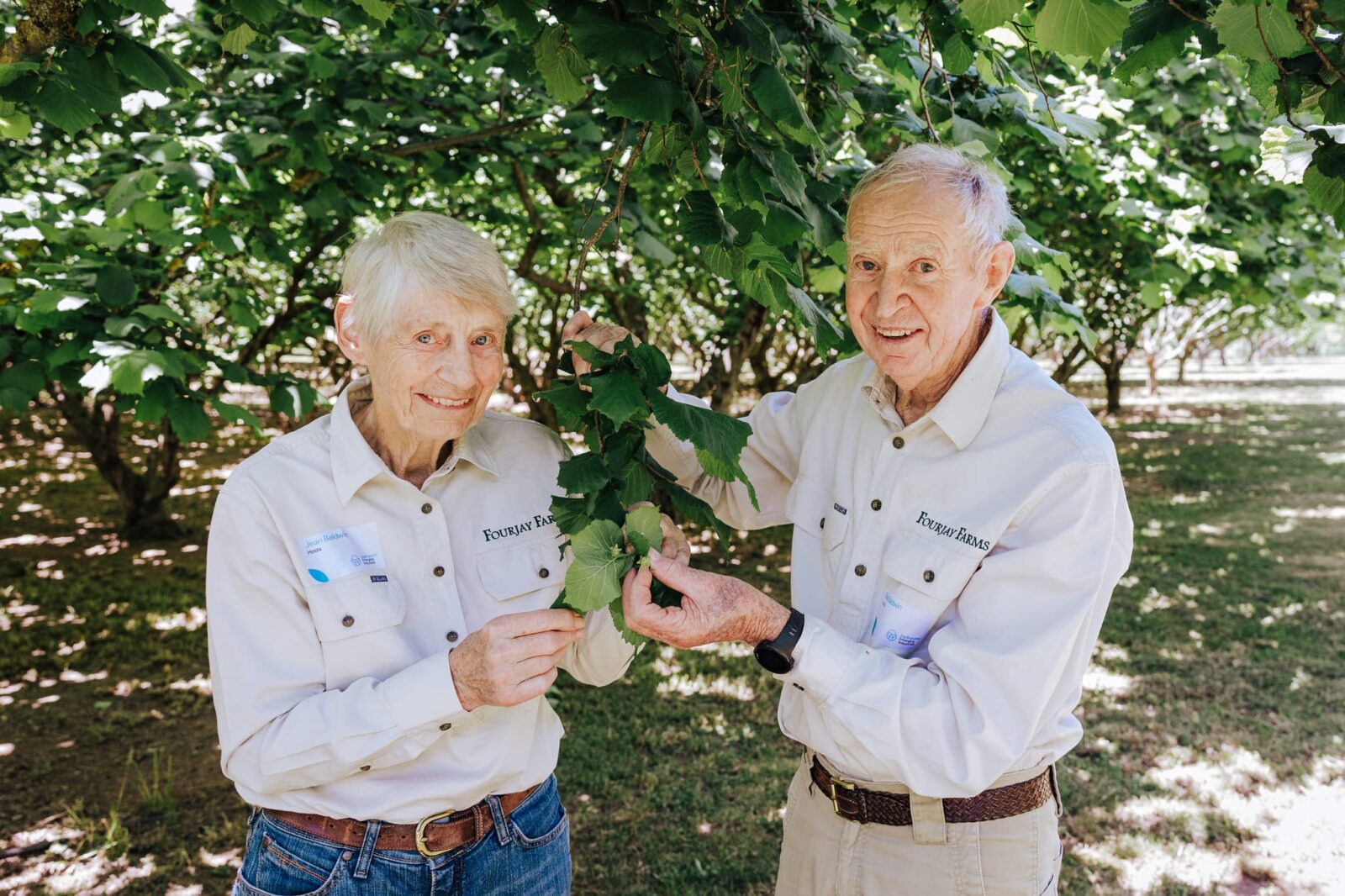Building a healthier future for sheep: Meet Horizon Scholar Chloe Frank
 EMERGING INDUSTRIES / Friday, 8 November 2024
EMERGING INDUSTRIES / Friday, 8 November 2024
Hazelnut investment pays lifestyle and financial dividends

In the soft rolling hills outside of Orange, NSW the paddocks of grazing sheep are interrupted by row upon row of hazelnut orchards.
The shift in the landscape is a sign of the gradual expansion of the industry as it becomes a popular option for tree changers and long-term investors seeking the right balance of rural lifestyle and retirement returns.
Basil and Jean Baldwin, both now in their 80s, have been pioneers in the industry, and continue to play an active role in the day-to-day operations of Fourjay Farms, a 5000-tree operation they run in partnership with daughter Carolyn and her husband Dave Stansfield.
Both generations have built the thriving business while pursuing full-time professional careers, with the Stansfields planning to follow the Baldwins’ lead in placing the hazelnut orchard at the centre of an active yet flexible retirement at some stage into the future.
Basil says the reality of hazelnut farming is that “you’re definitely not pegged to the orchard all the time”, with the couple travelling for three weeks each July when the orchard is dormant.
“That is a benefit of growing something like trees because you don’t need to be with them all of the time,” Basil said. “If you’re active and like country lifestyle, go for it! It’s been a great journey and you meet lovely people, other nut growers with a common interest and you share information, which is a lovely thing about agriculture.”
This flexibility was a big part of the appeal for Dave, who works remotely from the farm while running an engineering business full time.
“It was always a retirement plan to be able to do focus on the orchard when I finish drawing pictures for a living,” Dave said. “I can come and do something that’s already here, that’s built, it’s done and I can transition into that. I wouldn’t transition into a retirement thing where I didn’t have anything to do.”
Dave said the key was to start thinking about both retirement activities and financial security early, and assessing how to incorporate establishing an orchard into their lifestyle while working full time.
“It depends on how much time people have got. Our daughter Brooke was born when we were planting trees – we’d push the pram along and then plant another tree,” he said. “And you’ve got to be able to put aside at least 10 years for the trees to mature and the orchard to reach full production.”
Shortening the break-even period through new varieties that reach commercial viability sooner, more efficient farm practices and new value-adding opportunities are among the current challenges being tackled by AgriFutures Australia, which is investing $2 million in research and development over the next five years to transform hazelnuts from an emerging sector to a mainstream industry.
Assisting family farming operations to scale up is key to achieving that goal. While the part-time approach has worked well for the Baldwins and Stansfields, with both couples saying they would not have been able to build the 5000-tree business without each other’s support.
Although Basil says that if he was a younger man, and the farm had access to more irrigation water, he would be chasing a 10,000-tree orchard to maximise returns via economies of scale.
“In the early days it was slow but we were both working in the early stage of our orchard establishment so we weren’t necessarily looking for money straight away. We could afford to wait for that period,” Basil said.
“But if you’re trying to do it commercially you want your trees to come into production as early as possible and the key is good planting material… and that will give you a march of a year or two and you’ll have nuts within the first 2-3 years.”
While hazel trees begin to bear at about 3 years old, it usually takes 6 or 7 years to achieve commercial yields. Research into productivity and expansion of the hazelnut industry in Australia has previously found that yields of three tonnes per hectare are required for economic viability.
Even at the orchard’s current size the families have been able to benefit from the easy and flexible nature of growing hazelnuts – for example, even at busy periods like pruning only one quarter of the trees need to be trimmed (adult trees only require significant pruning once every four years).
“My background is not farming, it’s construction,” Dave said, “but it’s a fairly easy crop to understand and to work with. For a novice person with limited knowledge you can be successful.
“They’re not a demanding crop like the softer fruits. And they’re not like keeping an animal – they’re not going to run through yards, or run through the fences, and you can get away from things for a while.”
According to Hazelnut Growers Australia Inc, hazelnuts are currently grown in the temperate areas of south-eastern Australia including the Central Tablelands of New South Wales and northeast Victoria. They are also grown in central and eastern Victoria and increasingly in northern Tasmania, with a small levels of production in South Australia and Western Australia. New areas of hazelnut plantings have extended into southern New South Wales, eastern Victoria and throughout wider regions of Tasmania.
The adventure of learning to grow something new and different was part of the appeal for the Basil and Jean.
“When we started to grow them, we knew next to nothing about them and I thought that would be an interesting challenge to learn how to grow something and produce something that other people weren’t doing,” Basil said.
It also made good economic sense. The local chefs relished the opportunity to access fresh hazelnuts to make everything from nougat to dukka, biscuits to crumble, in chocolates or salads, or fresh on their own.
It wasn’t long before they developed a following at the local farmers’ markets, and as the orchard has grown their reputation has spread, supplying major food processing businesses in South and Western Australia, as well as exporting their own line of value-added products.
“The most rewarding part for me is having lots of happy customers. The latest comment was that our nuts are worlds better than anything they’ve used before and that was from a chef,” Jean said.
“We’re really price makers because when people find our nuts they will pay whatever we ask them to pay. We don’t ask them to pay ridiculous prices, but they are a very good proposition.
“And they’re so good for you – why wouldn’t you want to grow them?”
Basil and Jean’s top tips
- Select a site with good quality and well-drained soil
- Make sure the block has access to irrigation water
- Avoid stony ground – this can cause problems at harvest when collecting nuts off the ground
- Flat to gentle slopes are better to avoid the risk of erosion
- Wind protection is important when establishing young trees
- Find a quality nursery and give plenty of notice to secure the number of trees required
Latest News
-
Building a healthier future for sheep: Meet Horizon Scholar Chloe Frank WORKFORCE AND LEADERSHIP / 08.11.24
WORKFORCE AND LEADERSHIP / 08.11.24 -
One year review: Embracing new ways to evaluate the risks of yearling endoscopy THOROUGHBRED HORSES / 08.11.24
THOROUGHBRED HORSES / 08.11.24 -
How Isabelle Duff aims to drive genetic innovation in agriculture WORKFORCE AND LEADERSHIP / 08.11.24
WORKFORCE AND LEADERSHIP / 08.11.24 -
AgriFutures Australia welcomes new Chairman CORPORATE / 08.11.24
CORPORATE / 08.11.24






